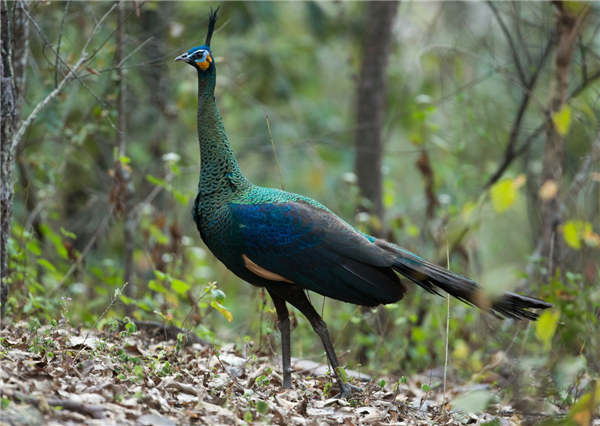
The great green peacocks are picky about their living environment. River valleys with gentle slopes and tropical monsoon forests in Yunnan can offer them the proper humidity, sufficient food, drinking water and open space. [Photo by Xi Zhinong/China Daily]
The term "peacock" is usually used to refer to peafowl of both sexes. Technically, only males are peacocks. Females are known as peahens, but collectively the birds are termed peafowl.
There are two main peafowl species. The blue peafowl mainly lives in India and Sri Lanka, while the green peafowl is found in countries such as China, Vietnam, Thailand and Myanmar. A more distinct but little-known species, the Congo peafowl, lives in African rainforests.
The green peafowl belongs to the pheasant family, and there are estimated to be 15,000 to 30,000 of these birds worldwide.
From peacock brocade and ancient murals, to imperial fans made from peacock feathers, the beautiful green peafowl was a symbol of good luck and nobility in traditional Chinese culture. During the Qing Dynasty (1644-1911), only high-ranking officials were permitted to wear hats with a green peafowl feather.
The species was once common in China. The Dai people in the southwestern province of Yunnan refer to the birds as "golden peafowl", as depending on the angle of the light, their feathers change color from green to blue, copper and gold.
Archaeological findings, including 4,000-year-old bones excavated in the central province of Henan, suggest that green peafowl were once widely found south of the Qinling Mountains and Huaihe River.
Yang Xiaojun, an ornithologist at the Kunming Institute of Zoology, said green peafowl were widespread in provinces and autonomous regions, including Hunan, Hubei, Guangdong and Guangxi, but they have only been sighted in Yunnan since the 1990s, when the species locally had an estimated population of 800 to 1,100.
In 2009, the green peafowl was listed as endangered on the International Union for Conservation of Nature's Red List of Threatened Species. In 2017, the authorities in Yunnan listed the green peafowl as critically endangered.
Male peafowl are known for their tail feathers, or coverts, which spread out in a distinctive train comprising more than 60 percent of the bird's body length and which boast markings in blue, gold, red and other colors.
This lengthy train is used in mating rituals and courtship displays. It can be arched into a magnificent fan that reaches across the bird's back and touches the ground on either side. Females are believed to choose their mates according to the size, color and quality of these feather trains.
Peafowl eat insects, small animals and plants. Males sometimes form harems of several females, each of which will lay three to five eggs.
Yang said: "In the wild, green peafowl breed once a year. They are timid and will abandon their nests and run away at the slightest sign of trouble. The chance of hatching a healthy green peafowl is very low."
Source: National Geographic and Kunming Institute of Zoology